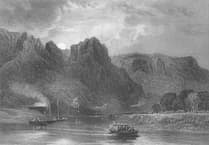SQUIRRELS could be to blame for putting rock climbers’ lives at risk on a Wye Valley cliff face.
The British Mountaineering Council has issued an alert after rope slings holding abseil and belay anchors were found damaged on the appropriately named Shorn Cliff overlooking Tintern.
The limestone rock face is popular with climbers, boasting 186 routes with names like Touch the Fire, Dazed and Confused, Blind Rage and Ramraider.
But at least two of the anchor points on the 10m to 30m climbs now appear to have been chewed part way through, with the finger of blame pointing at the local population of grey squirrels.
“We’ve received reports of what appears to be rodent damage to rope slings which form part of the belay and abseil anchors for several routes at Shorn Cliff in the Wye Valley,” said the BMC’s Rob Dyer.
“Damage has been reported to rope and cords at two belay/abseil stations in the Great Central Cave area, with what seems to be chew marks from rodents, perhaps squirrels, on the rope slings, and will undoubtedly have effected the strength of the anchor.
“The climber who made the report replaced the rope at the top of State of Independence, but an additional station above All For One and Bitter Battle Tears was in a similar state and wasn’t replaced.
“It is entirely possible that further fixed anchors have also been affected, so climbers are urged to be especially cautious before committing to using any fixed belay/abseil stations at this crag.”
The BMC describes Shorn Cliff as “a fantastic natural limestone crag with a real ‘away from it all’ feel, set in the woods above Tintern, with a plethora of good quality single pitch routes up to 30m long, often on very good quality pocketed limestone.”
“The routes top out onto densely-vegetated slopes, which means the default descent is to abseil from trees at the top of the crag,” added Rob.
“Over the years, these have become well established, with climbers adding fixed rope slings and abseil rings to prevent damage to the trees and allow ropes to pull more easily.”
He advised climbers to check any fixed gear on the crag, and use their best judgement to decide if it’s reliable before using it, including the full length of any rope, cord or webbing for damage.
They should also carry a spare length of cord/rope and a knife to remove and replace any fixed gear which looks questionable, and report any further damage found to [email protected]





Comments
This article has no comments yet. Be the first to leave a comment.